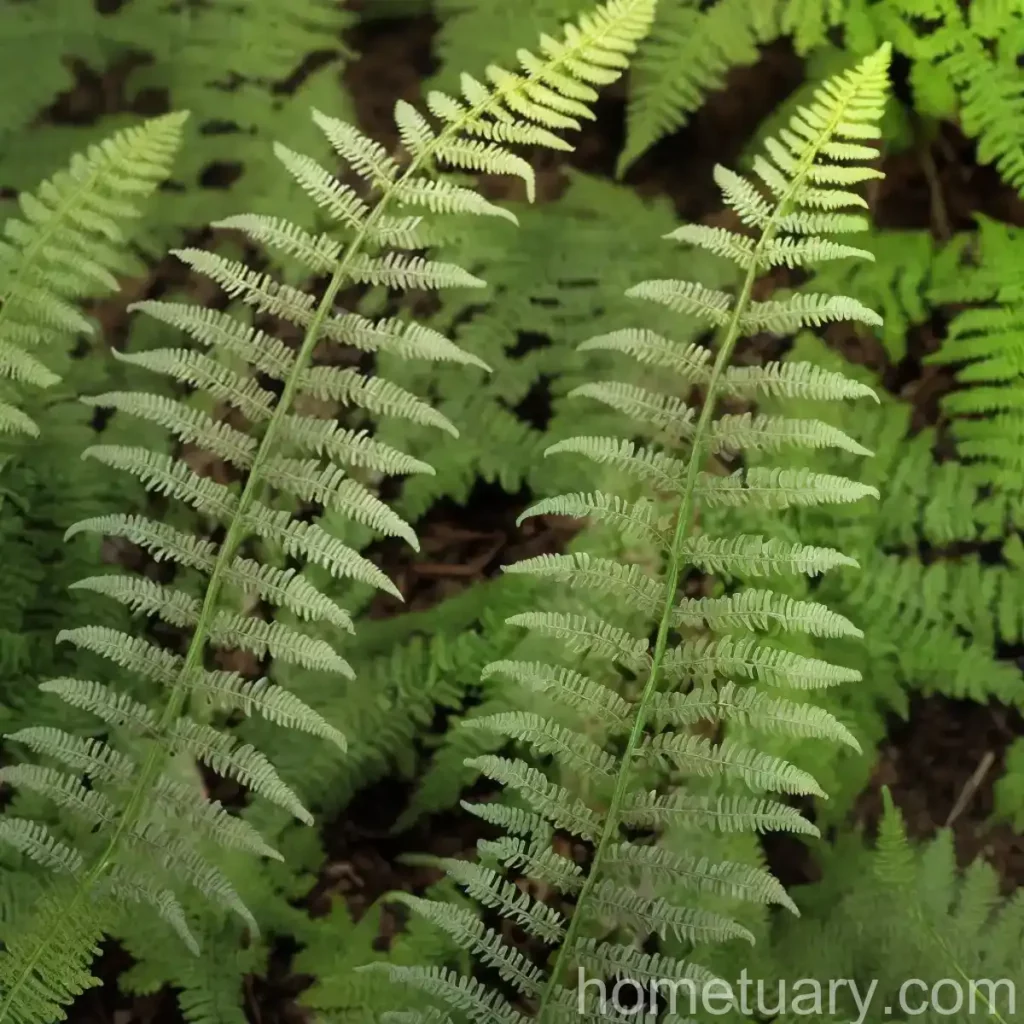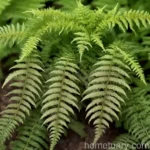Male Fern (Dryopteris filix-mas ‘Linearis Polydactyla’)
As a plant scientist, I am passionate about exploring the diverse world of plants. In this blog post, I will delve into the intriguing realm of the male fern, specifically focusing on the variety Dryopteris filix-mas ‘Linearis Polydactyla’. We will unravel the cultural significance, uses, care requirements, propagation methods, common diseases and pests, along with some fun facts about this fascinating fern species.
What is the Male Fern (Dryopteris filix-mas ‘Linearis Polydactyla’)?
The male fern, scientifically known as Dryopteris filix-mas ‘Linearis Polydactyla’, is a remarkable perennial fern that belongs to the Dryopteridaceae family. This fern variety is characterized by its finely divided, feathery fronds and robust growth habit. The ‘Linearis Polydactyla’ cultivar is particularly distinguished by its linear, elongated fronds with a delightful polydactyl form, which means that the fronds have more than the usual number of leaflets.
Key Takeaways – Male Fern (Dryopteris filix-mas ‘Linearis Polydactyla’):
- Botanical Name: Dryopteris filix-mas ‘Linearis Polydactyla’
- Common Name: Male Fern
- Variety: Linearis Polydactyla
- Plant Type: Perennial Fern
- Family: Dryopteridaceae
- Native Habitat: Europe, Asia, and North America
Let’s embark on an enriching journey to understand the culture, uses, and care guidelines for this splendid fern variety.
Culture of Male Fern (Dryopteris filix-mas ‘Linearis Polydactyla’)
The male fern is known for its adaptability and resilience, making it a popular choice for gardens, natural habitats, and landscape designs. Understanding the cultural requirements of this fern is crucial to ensure its optimal growth and health.
Uses
The male fern, particularly the ‘Linearis Polydactyla’ variety, offers a multitude of uses and benefits, including:
- Ornamental Display: With its lush, finely-cut fronds, the male fern serves as a stunning ornamental plant, adding grace and texture to any garden or landscape.
- Shade-Loving Accent: This fern variety thrives in shaded areas, making it an ideal choice for landscape designs that require foliage for shaded spots.
- Habitat Restoration: Male ferns are instrumental in ecological restoration projects, especially in recreating natural habitats where their presence is essential for biodiversity.
- Medicinal Purposes: Some traditional medicinal practices incorporate certain fern species, including the male fern, for their potential health benefits.
Care Guidelines for Male Fern (Dryopteris filix-mas ‘Linearis Polydactyla’)
To cultivate a healthy and vibrant male fern, it is vital to provide the appropriate care in terms of water, sunlight, soil, fertilizer, pruning, and propagation. Let’s explore each aspect in detail.
Water
- Moderate Moisture: Male ferns thrive in consistently moist soil, but they are susceptible to root rot if the soil is excessively waterlogged. Adequate drainage is crucial to prevent water stagnation around the roots.
- Avoid Drought: While these ferns appreciate moisture, they should not be subjected to prolonged periods of drought. Regular watering is essential, especially during dry spells or in containers.
Sunlight
- Shade-Loving: Male ferns, including the ‘Linearis Polydactyla’ variety, prefer shaded or partially shaded environments. Direct sunlight can scorch the delicate fronds, so dappled shade or filtered light is ideal for their growth.
Fertilizer
- Organic Enrichment: Incorporating organic matter such as compost or well-rotted manure into the soil during planting provides the necessary nutrients for the fern’s establishment and initial growth.
- Moderate Feeding: Once established, male ferns benefit from a balanced, slow-release fertilizer applied in spring to support healthy foliage development.
Soil
- Well-Draining Medium: Male ferns thrive in rich, well-draining soil with adequate organic content. A combination of peat moss, loam, and compost creates an ideal growing medium for these ferns.
- Acidic Preference: These ferns generally prefer slightly acidic soil with a pH range of 5.5 to 6.5. Amending the soil with acidicifiers like pine needles or coffee grounds can help maintain the appropriate pH levels.
Pruning
- Minimal Pruning: Male ferns typically do not require extensive pruning. Removal of any damaged or discolored fronds can be done to maintain the plant’s aesthetics and overall health.
Propagation of Male Fern (Dryopteris filix-mas ‘Linearis Polydactyla’)
The propagation of male ferns, particularly the ‘Linearis Polydactyla’ variety, can be accomplished through various methods such as division, spore sowing, and tissue culture. Understanding the propagation techniques enables enthusiasts to expand their fern collection and share these captivating plants with others.
Division
- Healthy Rhizomes: Dividing the rhizomes of mature male ferns is a common and effective method of propagation. Each divided portion should ideally contain a section of the rhizome with several healthy fronds.
- Spring Division: Early spring, just as new growth emerges, is an optimal time for dividing male ferns. This allows the divided sections to establish themselves during the active growing season.
Spore Sowing
- Fertile Fronds: Male ferns produce spores on the underside of their fertile fronds. Collecting the ripe spores and sowing them on a suitable growing medium initiates the germination process, leading to the development of new fern plants.
Tissue Culture
- Laboratory Propagation: Tissue culture involves the propagation of male ferns in a laboratory setting, where small sections of the plant, such as the rhizome or frond tissues, are cultured in a nutrient-rich medium to stimulate growth.
Male Fern in Container Gardening
The versatile nature of male ferns, including the ‘Linearis Polydactyla’ variety, extends to their suitability for container gardening. This section will provide insights into their popularity and the requisite care for cultivating these ferns in containers.
Popularity in Containers
- Space-Efficient: Male ferns are favored for container gardening due to their ability to thrive in limited spaces, making them an excellent choice for patios, balconies, and small gardens.
- Indoor Décor: The ornamental appeal of these ferns, coupled with their adaptability to indoor environments, contributes to their popularity as indoor container plants.
Care in Containers
- Drainage: Utilizing containers with adequate drainage holes is essential to prevent waterlogging and maintain optimal soil moisture levels for the ferns.
- Moisture Management: Regular monitoring of soil moisture and appropriate watering practices are crucial for container-grown male ferns, as they are more susceptible to drying out compared to those planted in the ground.
Common Diseases Affecting Male Fern (Dryopteris filix-mas ‘Linearis Polydactyla’)
While male ferns are relatively resilient, they can be susceptible to certain diseases and ailments. Recognizing these conditions and implementing appropriate measures is imperative to safeguard the health of the ferns.
Disease Diagnosis
- Rhizome Rot: Prolonged waterlogging or poorly drained soil can lead to rhizome rot in male ferns. Symptoms include wilting fronds, yellowing foliage, and mushy rhizomes. Addressing the underlying drainage issue and adjusting watering practices can alleviate the condition.
- Fungal Leaf Spots: Fungal pathogens can cause unsightly leaf spots on male fern fronds. Good air circulation, avoiding overhead watering, and applying preventive fungicidal treatments can help manage this issue.
Common Pests Affecting Male Fern (Dryopteris filix-mas ‘Linearis Polydactyla’)
Male ferns are generally resilient against pest infestations, but certain opportunistic pests can cause damage if their population goes unchecked. Understanding these potential threats and implementing proactive pest management measures is essential for preserving the vitality of the ferns.
Common Pests
- Aphids: These small, sap-sucking insects can colonize the tender fronds of male ferns, causing leaf distortion and sap depletion. A strong blast of water or the application of insecticidal soap can help control aphid populations.
- Spider Mites: These microscopic pests can negatively impact the overall health of male ferns by causing stippling on the foliage and fine webbing on the fronds. Miticides and regular misting to increase humidity can aid in controlling spider mite infestations.
Botanist’s Tips for Growing Male Fern (Dryopteris filix-mas ‘Linearis Polydactyla’)
Drawing from botanical expertise and practical insights, here are some valuable tips for cultivating and caring for male ferns, specifically the ‘Linearis Polydactyla’ variety:
- Monitor Soil Moisture: Regularly assess the soil moisture levels and adjust the watering frequency based on the environmental conditions to maintain optimal moisture for the ferns.
- Mulch Application: Applying a layer of organic mulch around the base of male ferns helps conserve soil moisture, suppress weed growth, and enrich the soil as the mulch breaks down.
- Seasonal Adjustments: Tailoring care practices such as watering, fertilization, and protection from extreme temperatures based on the seasonal requirements contributes to the overall health and vigor of male ferns.
Fun Facts About Male Fern (Dryopteris filix-mas ‘Linearis Polydactyla’)
Embracing the enchanting allure of male ferns, here are some captivating fun facts about the ‘Linearis Polydactyla’ variety and its broader species:
- Ancient Healing: The rhizomes of certain fern species, including the male fern, were historically used in traditional herbal remedies, although it is essential to exercise caution due to potential toxic properties.
- Ecological Allies: Male ferns serve as hosts for various beneficial insects and wildlife, contributing to the intricate web of biodiversity in their native habitats.
- Fern Fiddleheads: The emerging fronds of male ferns, known as fiddleheads, have cultural and culinary significance in certain regions, where they are harvested and prepared as a seasonal delicacy.
Links to External Resources
For further exploration of male ferns, gardening tips, and detailed plant care guides, consider the following external resources:
- The American Fern Society: An authoritative source for fern enthusiasts, offering extensive information on fern species, cultivation, and conservation.
- Royal Horticultural Society (RHS) – Growing Ferns: The RHS provides comprehensive guidance on growing ferns, including maintenance, propagation, and recommended varieties.
- Botanic Gardens Conservation International (BGCI): A global network advocating for plant conservation and sustainable horticultural practices, encompassing valuable insights for fern cultivation and habitat preservation.
Conclusion
In conclusion, the male fern, especially the captivating variety Dryopteris filix-mas ‘Linearis Polydactyla’, stands as a testament to the timeless allure and ecological significance of fern species. From its ornamental value to its ecological contributions, this resilient fern enriches diverse landscapes and serves as a symbol of natural beauty and resilience.
As plant enthusiasts and scientists, let us continue to explore, appreciate, and advocate for the conservation of such invaluable botanical treasures, ensuring that future generations can revel in the splendor of ferns, including the remarkable male fern variety.
Remember, the world of plants is a treasure trove of wonder and discovery, and in nurturing and understanding these botanical marvels, we cultivate a deeper connection to the natural world.
Keywords: Dryopteris filix-mas ‘Linearis Polydactyla’, Male fern plant, Dryopteris filix-mas variety, Linearis Polydactyla fern, Ferns for the garden, Hardy fern species, Fern varieties, Evergreen ferns, Ornamental fern plants, Shade-loving ferns, Ferns for landscaping, Low maintenance ferns, Perennial fern species, Ferns for natural habitats, Native ferns, Ferns for borders, Ferns for containers, Ferns for shade gardens, Fern care tips, Growing ferns, Caring for Dryopteris filix-mas ‘Linearis Polydactyla’, Fern propagation methods, Ferns for indoor spaces, Ferns for hanging baskets, Ferns for vertical gardens, Ferns for rock gardens, Ferns for wet areas, Ferns with unique foliage, Ferns for ferneries, Ferns for ground cover, Ferns for edging, Ferns for terrariums, Ferns for medicinal purposes, Ferns for herbal remedies, Landscaping with Dryopteris filix-mas ‘Linearis Polydactyla’, Companion plants for male fern, Ferns and butterflies, Ferns and pollinators, Ferns and beneficial insects, Ferns and humidity levels, Ferns for erosion control, Ferns for Japanese gardens, Ferns for bog gardens, Ferns for coastal gardens, Ferns for water features, Ferns and air purification, Ferns and air quality, Ferns and Feng Shui, Ferns and interior design, Ferns as natural art forms















